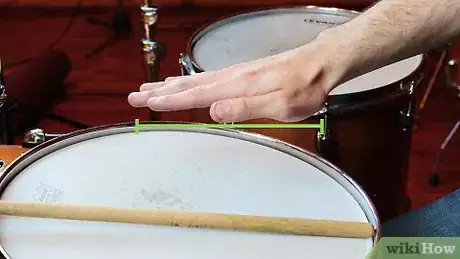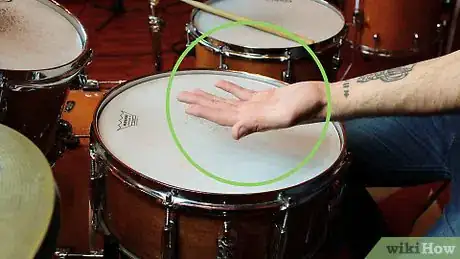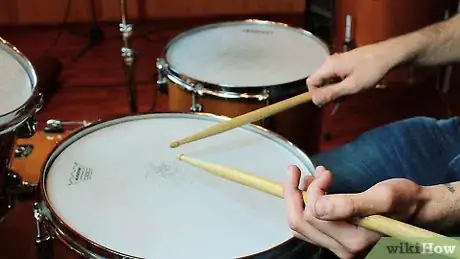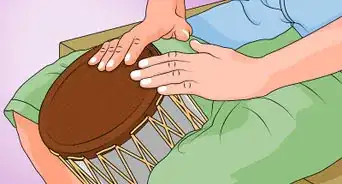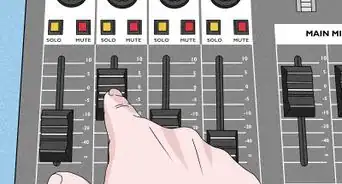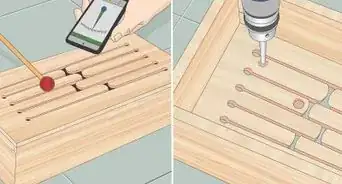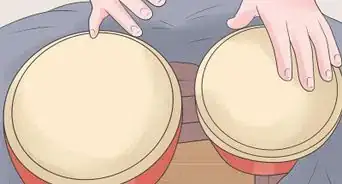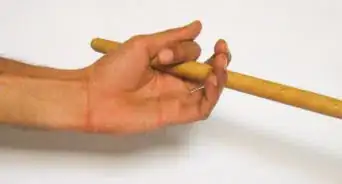This article was co-authored by Matt Khoury, a trusted member of wikiHow's volunteer community. Matt Khoury is a seasoned drummer with over 25 years of experience. He started playing in high-school band and at church, which expanded into opportunities to play with bands in front of thousands of people across the United States.
This article has been viewed 526,784 times.
Learn more...
When it comes to drumming, you've got to crawl before you can walk! To play the drums properly, good form when holding your drumsticks is essential. However, there's more than one type of grip you can choose from, and the grip you choose can affect how much power or control you'll have while playing. Whether you choose to play with typical "American"-style grip or opt for German, French, or Traditional grip instead, proper form and technique can make the difference between perfect playing and a sloppy sound (not to mention wrist pain!)
Steps
Playing with American Grip
-
1Point your index finger forward. For novices, the easiest grip style to begin with is usually American grip. This style is versatile, fairly easy to learn, and offers a good mix of power and control, making it a good choice for almost every drummer and almost every style of music. To begin, raise one hand and turn your wrist so that its palm is facing down and its index finger is pointed out straight ahead, parallel with the floor
- For this grip (and the styles below), you'll want your hands to be about an inch (2.5cm) or two above the snare drum head (assuming that you're playing at an ordinary drum set). However, if this isn't comfortable for you, feel free to move your hands to a position that is.
-
2Curl your index finger in. Next, bend your index finger at its second and third knuckles so that its tip is more or less aligned with the edge of your palm. This will form a small "pocket" that will act as a fulcrum for the drumstick as well as its primary point of support.Advertisement
-
3Place your drumstick under your index finger. Slide the drumstick into the curled-up pocket formed by your index finger. Your index finger should comfortably wrap around the drumstick as if it's pulling a trigger.
-
4Find the balance point. When you play the drums, you want your sticks to have a little "spring" or "bounce" when they hit the drum head — they should rebound from the drum head and fall back onto it several times with no effort from you. Experiment by sliding your drumstick up and down in its "pocket" until you find the stick placement that gets the most rebounds off the snare drum. You should get about 6-8 bounces when you find the correct balance point.
- Though all sticks will be weighted slightly differently, normally, the balance point will be about two-thirds of the way back from the stick tip.
-
5Place your thumb on the side of the drumstick. When you've found the balance point, turn your wrist so that your palm is facing toward the floor once again. Lay your thumb along the side of the drumstick. Keep it on the side — don't turn your palms towards each other to position it on top of the stick (this is what you would do for French Grip).[1]
- You don't need to apply much pressure with your thumb, — its job is to simply hold the stick in place and provide a little extra control when playing.
-
6Curl the last three fingers onto the drumstick. Wrap your middle, ring, and little finger around underneath the drumstick. Don't grip tightly with these fingers— they should provide good support, but shouldn't prevent the stick from bouncing back from the drum head when you hit it. Eventually, if you study advanced finger control techniques, you'll learn to subtly use these fingers to play with delicate finesse.[2]
-
7Repeat the steps above for the other hand. The grip you use should be more or less the same for both hands. Because your grips for each hand match, this type of grip is called a "matched grip".
- American grip isn't the only kind of matched grip — below, you'll learn several more which offer their own advantages and disadvantages.
-
8Strike with a wrist and finger motion. When you're ready to play, hit the drum by flexing your wrist to move the drumstick up and down. Keep your palms facing downward so that they're nearly parallel to the floor. This should ensure that the largest part of your wrist is doing most of the bending. Adjust the tightness of your thumb and supporting fingers to give the stick more or less bounce as needed. Keep your shoulders, forearms and elbows loose, but avoid moving them while you drum unless you need to move to a different drum or cymbal. The drumming motion should come almost entirely from your wrists and fingers.
- American grip is highly versatile. Because it offers great control and respectable power while playing, it's a viable choice for anything from swing and jazz drumming to rock and roll to funk and even classical music!
Playing with German Grip
-
1Grab at the balance point as with the American Grip. Today, the American-style grip described above is generally considered the most commonly-used variety matched grip. However, it is far from the only matched grip. For instance, a grip style called German grip is one common variation on the basic American grip that is sometimes used to give the drummer additional power (especially for timpani and bass drums in classical music). To use a German grip, start by finding and gripping the balance point of your sticks exactly as you would above.
-
2Make your palms parallel to the drum surface. Next, when you have a good grasp on your drumstick, turn your hands so that the flats of your palms are facing the drum surface. Because the vast majority of drums are set up so that the striking surface is roughly level with the floor, this will mean turning your hands so that your palms are facing downward. However, some types of drums, like bass drums, are set up vertically, which means you'll need to turn your palms so that they face sideways.
-
3Use your middle fingers for support. Curl your middle fingers underneath the stick so that it rests comfortably on them. Your ring and pinky finger are less important in the German grip than they are in other types of grips — you may use them for solid support if you wish by wrapping them around the stick or simply fold them loosely underneath.
-
4Let your elbows bend out.[3] When you use the German grip, if you're playing on an ordinary drum that's set up horizontally (like most snare drums, tom toms, and so on), your palms will be more or less parallel to the floor. Turning your hand this way has a tendency to make a drummer's elbows bend outward a little — if you notice that this is the case with you, don't feel the need to tuck your elbows in. With the German grip, letting your elbows bend outward can make it easier to get the power and control you'll need to play properly.
-
5Strike with a wrist motion. When you're ready to play, hit the drum by turning your wrist downward with a striking motion. The sticks should have a good "bounce" when they hit the drum — if they don't, you may need to adjust your grip position up or down the sticks slightly. Keep the striking motion in your wrist. Try to avoid using your arms, shoulders, or fingers.[4]
- The German grip is all about power — you shouldn't have a hard time producing loud, ringing hits with this grip, making it great for heavy rock drumming, marching band, and lively classical pieces. However, you may find it a little difficult to control your drumming during quick, intricate passages, making German grip less-suited for jazz drumming, technical rock drumming, and so on.
Playing with French Grip
-
1Grab at the balance point as with the American Grip. Another type of matched grip is the French grip. This style is somewhat unique among matched grips in that it mainly uses the fingers to power each drum hit, rather than the wrists. To hold your drumsticks in a French grip, begin exactly as you would for the American or German grip by finding and gripping your sticks' balance points with your thumb and first finger.
-
2Face the palms of your hands toward each other. Next, turn your palms inward so that they face each other. The flat parts of your palms should be facing up and down (perpendicular to the floor).[5]
- Your palms should be facing each other, but they shouldn't necessarily be close to each other. Keep your hands as far apart as feels natural — for most people,this will be about a foot or so.
-
3Use your middle, ring, and pinky fingers for support. Curl your middle, ring, and pinky fingers underneath each stick. As you play, these fingers will provide support for your sticks, helping you keep them under control. This is extra-important for the French grip because it uses your finger strength more heavily than the other matched grips do.
-
4Tuck your elbows in. Since you've positioned your hands so that their palms are facing each other, your elbows will probably have naturally dropped near to your sides. If they haven't, tuck your elbows in slightly so that they hang an inch or so from your torso.
- You don't need to be strict about this — as you play, you should find that your elbows naturally find a comfortable "resting" position somewhere near your sides. You just want to avoid having your arms bend outward at the elbows, which can reduce your playing power.
-
5Strike with your fingers. When you've found a comfortable stance and you're ready to start drumming, turn your wrists downward slightly and use your fingers to strike the drum with the sticks. Some wrist movement will probably be unavoidable, but most of the power for the drum hits should come from using the fingers to strike with the sticks, not from rotating your wrists or moving your forearms or shoulders.
- Because you're using your fingers to power your drum hits, French grip typically gives the drummer the ability to play with a little extra control and dexterity than wrist-oriented playing styles. This makes French grip a great choice for drumming that demands finesse, like jazz, technical rock, and certain types of technical "Drumline"-style pieces. However, because the fingers don't have as much strength as the wrist, French grip can be a bad choice for the loud, powerful drumming demanded by hard rock, heavy metal, and so on.
Playing with Traditional Grip
-
1Turn your "off" hand palm side up. Traditional grip is unique among drum grip styles in that it's not a matched grip — that is, the way you hold the stick isn't the same for both hands. To play with a traditional grip, begin by raising your your non-dominant hand in front of you and turning it so its palm faces upward toward the ceiling.
- Note — traditional grip was originally used by military drummers who found it difficult to drum with a matched grip while on the march.[6] To maintain uniformity, the left hand was generally used to hold the stick with an upward-facing grip regardless of which hand was the drummer's dominant one. However, in a modern context, some left-handed drummers reverse the typical traditional grip and use their right hand as the upward-facing one.
-
2Place the stick in the space between the thumb and index finger. Lay the drumstick in the fleshy "crook" of the hand between the thumb and index finger on your non-dominant hand. Slide the drumstick up and down until you find its rough balance point, then line this up so that your hand is supporting the stick roughly at this point.
-
3Wrap your thumb and index finger around the stick. Bend your thumb so that it rests comfortably on top of the stick. Then, raise your index finger and lay it over the stick so that the inside portion of the finger is touching the stick.[7] This should feel somewhat less natural than curling your thumb over the stick, but it's important for giving your traditional grip playing solid control.
- When gripped properly, the pad of your thumb should be resting on the first knuckle of the index finger (or as near to it as possible) while the index finger should be curved over the top of the stick.
-
4Rest the bottom of your middle fingertip on the side of the stick. Bring your middle finger along the outer edge of the stick so that it touches the stick at the underside of the second or third knuckle. This may feel a little unnatural at first, but it shouldn't feel outright uncomfortable.
-
5Curl the remaining fingers under the stick. Next, bring your ring and pinky finger underneath the stick. Rest the stick on the cuticle of the ring finger or the knuckle of the middle finger and align the little finger under the ring finger for support. When gripped properly, your ring and little finger should be curved roughly the same way as your index finger.[8]
- With your index, ring, and pinky fingers curved in somewhat and your middle finger extended, it may look like you're "giving the bird". Don't worry! This is OK — in fact, it's a sign of good form.
-
6Use an overhand grip in your other hand. Your off hand is ready to play! Now, all you need to do is grip the other stick with your dominant hand in an overhand style just as you would for any of the matched grips above. You can use whichever grip is comfortable for you, but most find the typical American-style grip (or some minor variation on it) to be easiest.
-
7Strike with a wrist motion. In traditional grip, you'll want to use a primarily wrist-based motion to do your drum hits, turning your wrists downward to hit the drum. The obvious difference from other styles, of course, is that the upward grip you're using in your off hand requires a slightly different wrist motion than you may be used to. However, you're still turning both hands in the same direction as you normally would.
- Traditional grips are often used in jazz drumming and marching band drumming. Because it can be tricky to get the same level of power in your off hand as you would with an overhand grip, this style isn't always a good choice for the kind of loud, heavy drumming you might find in heavy metal, for instance.
Expert Q&A
-
QuestionWhy do drummers hold their sticks differently?
 Matt KhouryMatt Khoury is a seasoned drummer with over 25 years of experience. He started playing in high-school band and at church, which expanded into opportunities to play with bands in front of thousands of people across the United States.
Matt KhouryMatt Khoury is a seasoned drummer with over 25 years of experience. He started playing in high-school band and at church, which expanded into opportunities to play with bands in front of thousands of people across the United States.
Veteran Drummer Grips don't always stay the same throughout a song. I change my grip as it needs to depending on where my hands feel comfortable at the moment and how they'll react to the drum strike and the sound the sticks are creating. Do I want a rimshot? A side stick? I change it up all the time, and when you practice a lot, you'll find yourself unknowingly adjusting your grip, too!
Grips don't always stay the same throughout a song. I change my grip as it needs to depending on where my hands feel comfortable at the moment and how they'll react to the drum strike and the sound the sticks are creating. Do I want a rimshot? A side stick? I change it up all the time, and when you practice a lot, you'll find yourself unknowingly adjusting your grip, too! -
QuestionWhat would be best for a 12-year-old beginner?
 Community AnswerWell the easiest would probably be the matched grip, but you can choose whatever grip you like best. If you practice enough, you can master drumming with any grip.
Community AnswerWell the easiest would probably be the matched grip, but you can choose whatever grip you like best. If you practice enough, you can master drumming with any grip. -
QuestionI normally hold the matched grip with the stick resting on the first joint of my index finger. Is this permissible, or is it supposed to be held against the second joint or knuckle?
 Community AnswerTechnique is supposed to make what you want to play easiest and the most efficient. If you can justify what you're doing somehow, great! Personally, I think resting the stick on my 2nd joint (the middle joint) gives you the most control and keeps the stick from sliding around in my hand too much.
Community AnswerTechnique is supposed to make what you want to play easiest and the most efficient. If you can justify what you're doing somehow, great! Personally, I think resting the stick on my 2nd joint (the middle joint) gives you the most control and keeps the stick from sliding around in my hand too much.
References
- ↑ https://www.youtube.com/watch?v=BVfKpju_MBE
- ↑ https://www.youtube.com/watch?v=BVfKpju_MBE
- ↑ https://www.freedrumlessons.com/articles/hold-drumsticks.php
- ↑ https://www.libertyparkmusic.com/drum-sticks-grip-guide/
- ↑ https://www.libertyparkmusic.com/drum-sticks-grip-guide/
- ↑ https://drummagazine.com/thomas-lang-says-get-a-grip/
- ↑ https://drummagazine.com/thomas-lang-says-get-a-grip/
- ↑ https://drummagazine.com/thomas-lang-says-get-a-grip/
- http://www.freedrumlessons.com/articles/hold-drumsticks.php
About This Article
There are two main kinds of grips you can use to hold a drumstick. The first kind of grip is called a matched grip. With a matched grip, both of your hands are holding the drumsticks the same way. There are a few different styles of matched grips, including the American, German, and French grips. To use the American grip, open your palm with your thumb facing up. Curl your index finger in a little and rest the stick in between your index finger and thumb. Wrap your remaining fingers around the base of the drumstick. Strike your drums with your palms facing inward and your thumbs on top. To use the German grip, hold your drumstick the same way you would for the American grip, but play with the back of your hands facing up, not your thumbs. The German and American grips are most popular among rock drummers since you can hit the drums hard without losing your grip. To use the French grip, place your thumb on top of your drumstick and curl your index finger underneath. Let your other fingers hang under the drumstick to keep it from falling when you hit your drums. The French grip is popular with jazz drummers since it makes it easier to hit the drums quickly with a lighter touch. The second kind of grip you can use is a traditional grip. With a traditional grip, each hand holds its drumstick differently. In your right hand, wrap your fingers over the handle and place your thumb on the side of the drumstick. In your left hand, turn your palm up and wrap your index finger over the drumstick. Place your thumb on top of the drumstick and hold your middle finger out underneath. Curl your ring and pinky fingers up to brace the stick from the side. Some jazz musicians use a traditional grip, but it’s mostly used by marching band drummers to hit rim shots and regular drum hits differently. If you want to learn how to hold a drumstick using a traditional grip, keep reading the article!
